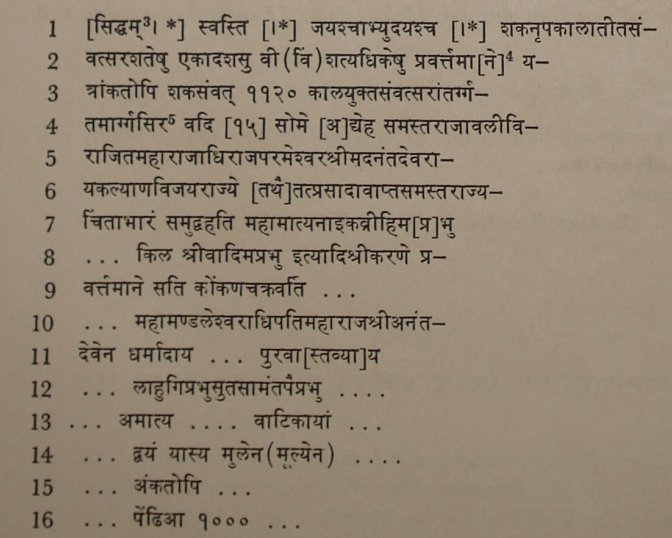|
The Indian Analyst
|
North Indian Inscriptions |
INSCRIPTIONS OF THE SILAHARAS OF NORTH KONKAN
other stones bearing inscriptions of the Śilāhāras, this stone also has the figures of the moon, the maṅgala-kalaśa and the sun at the top, and the figure of a cow and its calf at the bottom. The inscribed portion which lies between these figures measures 75 cm. by 34 cm. The inscription is in a bad state of preservation especially in the lower half. ..The characters are of the Nāgarī alphabet as in the other Śilāhāra inscriptions. The language is Sanskrit, with an admixture of Marathi words like pēṁḍhiam. ..The inscription refers itself to the reign of the king Anantadēva, who beras the royal titles Mahārājādhirāja and Paramēśvara. It is dated on Monday, the 15th tithi [1] of the dark fortnight of Mārgaśiras in the Śaka year 1120, the cyclic year being Kālayukta. This date is perfectly regular and corresponds to the 30th November A.D. 1198. This king Anantadēva is, therefore, different from the earlier homonymous king, whose records dated Śaka 1003 and 1016 have been discovered. He must, therefore, be called Anantadēva II. As the present inscription does not give his genealogy, it is not known how he was related to his predecessor Aparāditya II. Perhaps, he was his son, who succeeded him. He seems to have ruled for a short period ; for the next known date Ś. 1135 is of Kesideva II, who may have been his younger brother and successor.
..The object of the present inscription seems to have been to record some gift (now illegible) of King Anantadēva to some Brāhmaṇa. The inscription also records the gifts of some pēṇḍhīs (sheaves of corn) made by the Mahāmātya, his son and some other persons probably to the same Brāhmaṇa. The record ends with the usual benedictory and imprecatory verses. .. The inscription mentions the officers, the Mahāmātya Nāyaka Vrīhima Prabhu and one Vāhima Prabhu, whose designation is not clear in this record. No name of any locality occurs in the legible portion of the present inscription Text[2]
[1] Kolte read the tithi as 8, but there is space here for two figures, the second of which is clearly 5.
|
|||||||||||||||||||||||||||||||||||||||||||||||||||||||||||||||||||||||||||||||||||||||||||||||||||||||||||||||||||||
| > |
|
>
|








